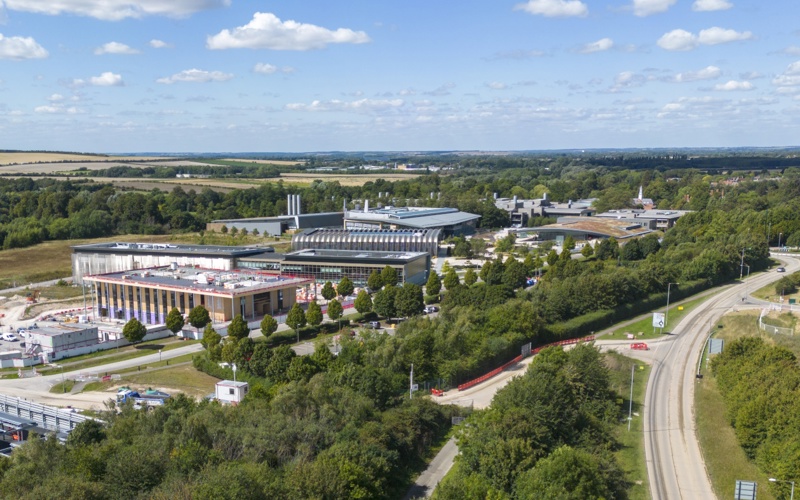A new report from the Greater Cambridge Shared Planning service highlights recent progress in meeting demand for new lab and office space across Cambridge and South Cambridgeshire.

A new report from the Greater Cambridge Shared Planning service highlights recent progress in meeting demand for new lab and office space across Cambridge and South Cambridgeshire.
The report was commissioned to inform the councils’ response to the large number of proposals for laboratory and office space, and to inform the emerging joint Greater Cambridge Local Plan. Its findings respond to previous government concerns about whether there was sufficient supply of new space in Greater Cambridge.
Work to produce the report drew on extensive engagement with sector leaders, science parks, developers and business, looking at the specific requirements for the fast growth life science and ICT sectors, to draw conclusions about the supply now available.
Following the granting of several planning permissions over the last year by the Greater Cambridge Shared Planning service, which is a partnership between Cambridge City and South Cambridgeshire District Councils, the report concludes:
- The supply for life science laboratory space for testing of drugs, chemicals or biological matter (known as “wet labs”) from 2025 to 2030 is now substantial and sufficient to meet the expected needs, although beyond 2030 further space will be required for the emerging joint Local Plan to meet anticipated needs to 2040 and beyond.
- Whilst the quantum of new wet lab space is sufficient, there may remain a shortfall in the critical smaller space for life science “start-up” businesses of up to five people and “scale-up” businesses of six to 10 people required to support new companies looking to grow on the back of research funding.
- The future supply for general office space, and for laboratory space involving dry materials or computer analysis (known as “dry labs”), which meets the needs of the burgeoning digital/ICT sector, appears relatively healthy looking ahead, however there are likely to be additional requirements later in the 2030s which the emerging joint Local Plan, which the two councils are working on together, will need to plan for.
Beneath the headline figures, the report highlights the pivotal role Greater Cambridge plays on the national and international stage in life science and tech evolution but makes clear that the area will need to continue to explore ways to enhance what it offers to support existing industries locally. This includes:
- Prioritising ‘place based’ business destinations for life science and ICT that offer high quality, modern, best-in-class workspaces that: preferably form part of a larger cluster to enable knowledge exchange; are in attractive settings; offer a range of amenities including food and beverage; and are well served by public transport as well as car. Recognising that even Greater Cambridge’s most successful life science locations such as Cambridge Biomedical Campus and Cambridge Science Park will need to evolve to provide these best-in-class workspaces.
- Seeking to ensure that the full range of premises in terms of size and format are offered, ensuring in particular that smaller start-up and scale-up businesses are able to grow within the ecosystem.
- The need for continued collaboration across Greater Cambridge institutions and agencies to ensure that the area can continue to provide a globally competitive best-in-class offer, recognising the importance that the quality of Cambridge and the surrounding South Cambridgeshire will play in the future, and the need for appropriate infrastructure solutions that improve transport and connectivity, as well as new housing that is affordable and accessible.
Commenting on the report, Cllr Katie Thornburrow, Cambridge City Council’s Executive Councillor for Planning, Building Control and Infrastructure, said: “I’m very pleased to see such a significant improvement in the supply of appropriate office and lab space across Cambridge and South Cambridgeshire, especially the vitally important ‘wet labs’ that are needed by companies working in the life sciences.
“Cambridge is nationally and internationally important and has a key role to play in the country’s future and in furthering the scientific endeavour that translates into national prosperity and improved opportunity and wellbeing for our local communities. This report commissioned by our planning service makes clear how we are listening to the business and research community and responding to the challenges facing knowledge intensive sectors, such as life sciences and digital.
“I’m also pleased to see that the report highlights how the councils’ planning committees have responded to calls for more space across these important sectors in line with our commitment to sustainable development and building great places. We recognise the challenges ahead and will continue to work with national government and our local partners to address the environmental, infrastructure and housing challenges facing the area.”
South Cambridgeshire District Council’s Lead Cabinet Member for Economic Development, Cllr Peter McDonald, said in response to the findings: “It is never easy to balance the environmental impacts of growth with the need for new homes and suitable employment spaces to support our successful economy in its continued growth. This report indicates the positive contribution, through the granting of planning permissions, that we have been able to make towards meeting those objectives.
“I am pleased that over the last year or so, the councils’ response has been the foundation to address the immediate and pressing need for more space with permission for significant new research, lab and office spaces. We are now keen to see that built. We also know that we will have to continue to work with Government and its agencies on addressing the associated infrastructure, housing and environmental challenges that the area’s success creates.”
The report has been published on the Greater Cambridge Shared Planning website.
In the coming weeks, a detailed employment trajectory, which informed the report’s findings, will also be published.
Glossary
Dry Lab: In the ICT and Life Science sectors in Greater Cambridge dry labs are generally required for genomic research and sequencing and some advanced tech research and development. However dry lab space is usually more associated with physical sciences and crosses over to advanced manufacturing R&D.
Dry labs focus on applied or computational mathematical analyses via the creation of computer-generated models or simulations in computing, engineering and physics. They tend to be lower cost and can be used by a range of sectors. Dry labs are different from offices as they are still about experimental activity and often still require “clean rooms” that may involve testing dry equipment or materials. Examples include the testing of electro-magnetic noise, semi-conductor development, computational modelling of space theories and quantum state analyses. Dry labs often require humidity and temperature control and dust control to ensure that any electronics are well maintained. Dry labs also typically require back office space for administration and write-up functions.
Wet Lab: Life science research often takes place in wet labs. Wet labs involve biological matter – these are controlled environments where drugs, chemicals and biological matter can be analysed and tested. Conducting experiments with these substances requires additional features, such as drain and vent services, chemical fume hoods and materials resistant to chemicals and bacteria. These are often high cost to develop and maintain. Life science research often requires wet lab space alongside office space, (back-office space for administration and write-up functions).
View all news
